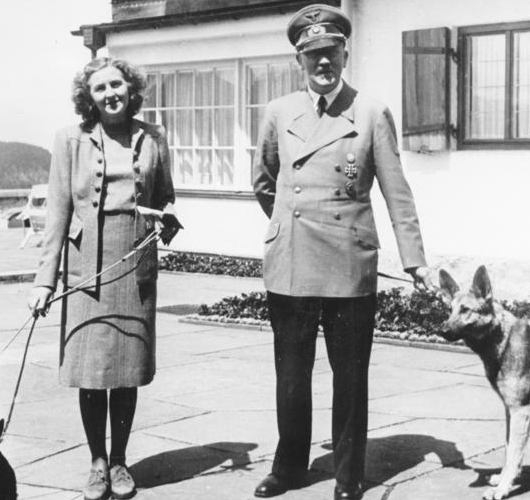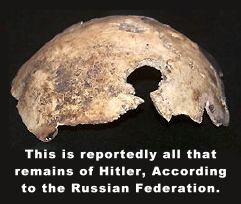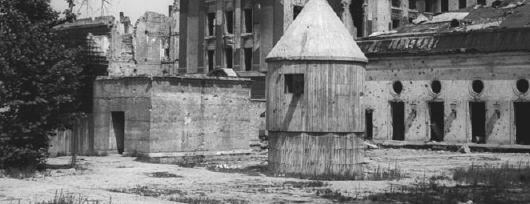The intriguing and strange story of how Adolf Hitler met his end, and beyond...
I have stumbled across several blogs and sites lately, where I have seen questions and arguments on how Adolf Hitler and Eva Braun died. All conspiracy theories aside, I thought I'd write a quick post on the topic with what I know to be (to the very best of my knowledge along with some research) to be the actual truth.
In the dying days of World War Two, Germany was besieged by enemies, most notably the Americans advancing from the West and the Soviet Red Army, advancing mercilessly from the East and North. Soviet leader Joseph Stalin spared nothing--including the lives of his own forces--to take Berlin at all costs. By this time in April of 1945, most of Germany's resources, food, fuel and other supplies were badly decimated. What remained of the German military was mostly cut off from it's own capitol and severely weakened. Berlin was a smoldering, burned out pile of bombed rubble, desperately trying to hang on by conscripting everyone who could be found to defend the remains of the city. Death and destruction was raining down on the ruined city around the clock. Hitler and his elite NAZI party HIgh Command staff were sequestered in the Furherbunker, a large underground complex, armored with concrete 4 meters thick, staging the last act of the once mighty Third Reich. The bunker was located deep beneath the Chancellory Gardens at Wilhelmstrasse 77 in Berlin, adjacent to Hitler's new Reichs Chancellory.

With unsurmountable setbacks being added daily, and with the unstoppable Soviet Red Army now only a few blocks away, Adolf Hitler had decided to commit suicide along with his new wife and former mistress, Eva Braun. Their marriage lasted less than 2 days before their suicides. Hitler feared falling into the hands of the Soviets alive, especially after hearing about the gruesome death of Italian fascist dictator Benito Mussolini, whose body was hung upside down from a beam in a macabre public display and his body mutilated by enraged locals. For that matter, he even expressed his wish to avoid his dead body falling into Soviet hands.
It had been ten days since Hitler had last been outdoors in the garden above. After a last dinner of spaghetti and tossed salad with Eva Braun, and a long wave of farewells, the two of them retired to Hitler's study on the afternoon of April 30, 1945, where they would commit suicide. The plan was for each of them to bite into a glass ampoule of cyanide while shooting themselves in the temple simultaneously. Adolf Hitler is said to have done exactly this, biting into his cyanide capsule while shooting himself in the temple with his 7.65 mm Walther PPK pistol. His wife apparently died from her cyanide ampoule before she had the chance to pull the trigger on her own Walther pistol. Both bodies were found dead on a sofa in Hitler's study ten minutes after a single gunshot was heard, as per Hitler's instructions. Hitler was said to have been bleeding from his temple, with his pistol lying on the bloodstained carpet after having fallen out of his hand. The two bodies, along with the bodies of several of his high command staff, who'd also committed suicide, were carried up into the Chancellory Gardens and burned in a bomb crater. These events quickly culminated in the unconditional surrender of Germany and the end of World War Two in Europe.

Later that day, the bunker was taken by Soviet forces, and the ultimate fate of the remains of the burned corpses is still not entirely certain. This had led to all manner of conspiracy theories and speculation. The most commonly accepted version of this story is that the Soviets removed the remains of Hitler and Eva from the bomb crater in the gardens above the Furherbunker, on or about May 5, 1945. They claim the bodies were buried at a Soviet Military base in Magdeburg, East Germany in 1946. They also claim that in the months that followed the collapse of Berlin at the end of the war, that the bodies of Hitler, Braun, Propaganda minister Joseph Goebbels and his wife and children were buried and unearthed, then reburied several times in different places around what was then East Germany. It would appear that the Soviet SMERSH and NKVD units wanted to keep the bodies nearby until they could receive a final order from Moscow. It is claimed that the final order did not come until 1970, when KGB Director (later General Secretary of the Soviet Union) Yuri Andropov ordered the bodies again exhumed, burned and the ashes permanently dispersed.
In 1992, under Boris Yeltsin's new Russian Federation government, information was released about the autopsy performed on Hitler's body, and the report closely matches the consistency of the story told about the suicide in Berlin in 1945. In 2000 the Russians presented a small, burnt skull fragment containing a bullet hole, once presumed to be Hitler's, but DNA testing by the United States in December 2009 has confirmed that it belonged to a woman, aged 20 to 40. It was later disclosed that the Soviets exhumed the bodies, secretly buried in Magdeburg, and once again burned them in 1970, under a veil of secrecy. This time, the cremation was claimed to be complete, and the ashes were claimed to have been dumped in Biederitz River. The Russians still claim to have a fragment of Hitler's skull and jawbone in their state archives, citing the historical importance of the remains. Though the ultimate fate of Hitler's remains are still mysterious, they almost definitely ended up in Russian hands, since the Soviets were the first to reach and overtake the Furherbunker in April 1945. The Soviet troops going into Berlin did so fearing the wrath of their enraged leader, Joseph Stalin, who absolutely would not take "NO" for an answer.

All told, over one million Soviet sol
d
iers died in
the quest to advance upon and take Berlin. Of all the casualties of
World War Two, both military and civilian, the Soviet Union had by far
the highest loss of life. It has been estimated to total at least 12%
of the entire population of the Soviet Union. While the other nations
involved in World War Two also suffered a large loss of life, they pale
in comparison to the staggering numbers of dead in the Soviet Union.
The Furherbunker itself proved to be an incredibly
strong fortress. In 1947, the small ventilation and access buildings
above the bunker were demolished by the Soviets, but attempts to
destroy the bunker below failed. Since it was located near what would
become the the Berlin Wall, (a Cold War monstrosity) the area
surrounding the bunker was mostly deserted, flooded and neglected.
Several
attempts were made to blow up the concrete remains below, but they were
too thick and strong. 4 meters of solid concrete shielding (13 feet)
proved to be a very good underground defense against bombs. Even by
today's standards. After the reunification of Germany, the government
feared the site might become a sort of shrine to neo-Nazis or
sympathizers, and the site was intentionally unmarked. At last, the
bunker was simply filled in and paved over. A Chinese restaurant and
parking lot occupied the innocuous-looking area in 2005. The only
visible trace of the bunker today is a small historical marker that
shows the approximate position of the old bunker entrance, which was
placed on the site in 2006.
In addition to the long and tragic story of World
War Two, the story of Hitler did not really end until December of 2009.
Whether or not there is any more, only time will tell.
We offer authentic
replica Walther PPK semiautomatic pistol.
We also offer a Blank-Firing replica Walther PPK
semiautomatic pistol, in blued or nickel-plate finish.